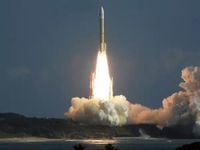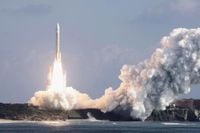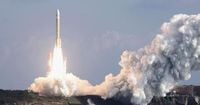Japan’s ambitions in space took a significant leap forward on October 26, 2025, as the Japan Aerospace Exploration Agency (JAXA) successfully launched its most powerful H3 rocket, carrying the brand-new unmanned cargo spacecraft HTV-X1. The launch, which took place at precisely 9:00 AM local time from the Tanegashima Space Center in Minamitane, Kagoshima Prefecture, marks a pivotal moment in Japan’s evolving role in international space logistics and lunar exploration.
According to JAPAN Forward, the H3 No. 7 rocket thundered into the sky, watched anxiously by JAXA and Mitsubishi Heavy Industries staff. Just 14 minutes after liftoff, the HTV-X1 spacecraft separated smoothly and was placed into its targeted orbit, prompting cheers and applause in the control room. This successful deployment is the first step in HTV-X1’s mission to deliver crucial supplies to the International Space Station (ISS), a journey expected to take about four days.
The HTV-X1 is the latest in a line of Japanese cargo vehicles, succeeding the H-II Transfer Vehicle known as Kounotori, or “stork,” which completed nine missions between 2009 and 2020. As The Associated Press reports, the new freighter offers significant upgrades: it can carry a larger payload, supply power during flight, and transport sensitive laboratory samples that require cold storage. These features are made possible by enhanced refrigeration and freezing capabilities, a crucial advancement for scientific experiments aboard the ISS.
Measuring approximately 8 meters in length and 4.4 meters in diameter, the HTV-X1 expands to a width of about 18.2 meters when its solar panels are deployed. It’s capable of carrying up to 5.85 tons of cargo, bringing its total mass to roughly 16 tons. Development costs for HTV-X are estimated at ¥35.6 billion (about $332 million USD), underscoring Japan’s significant investment in space infrastructure.
Upon its scheduled arrival at the ISS around October 30, Japanese astronaut Kimiya Yui, currently stationed aboard the orbiting laboratory, will play a key role. Yui is tasked with capturing the HTV-X1 using the station’s robotic arm. Sharing his excitement on social media, Yui posted, “It successfully entered orbit! I’ll make sure to grab it firmly with the robotic arm to meet everyone’s expectations!” (JAPAN Forward).
Once docked, the HTV-X1 will unload fresh food and experimental equipment, supporting both daily life and ongoing research on the ISS. The craft is designed to remain attached to the station for up to six months, during which it will also retrieve waste. After its primary mission, HTV-X1 will undock and conduct about three months of technology demonstrations in Earth’s orbit before re-entering the atmosphere and burning up. Notably, its operational flexibility allows it to function for up to one and a half years after undocking, opening new possibilities for extended missions and technology tests.
This launch also marks the debut of the H3 rocket’s most powerful variant, featuring four rocket boosters and a larger fairing to accommodate bulkier payloads. The H3 rocket, developed jointly by JAXA and Mitsubishi Heavy Industries, replaces the much-loved H-2A rocket, which made its final flight in June 2025. The new model is engineered to halve launch costs and preparation time, aiming to make Japan more competitive in the global commercial space market. According to Iwao Igarashi, head of the Space Business Department at Mitsubishi Heavy Industries, “Japan’s track record of on-time launch and accuracy in delivering payloads and the newly modified rocket prove they can accommodate a range of customer needs.”
The H3 rocket comes in three variants—standard, large, and small—depending on the payload. All six previous launches utilized the standard model, but the No. 7 launch was the first to use the large-capacity version. This successful flight is particularly significant, considering the H3’s rocky start; its debut in 2023 ended in failure when the rocket had to be destroyed with its payload. Since then, JAXA has achieved six consecutive successful launches, restoring confidence in Japan’s space launch capabilities.
Beyond cargo delivery, the October 26 mission carried another intriguing payload: a space-use brewing apparatus and sake ingredients, jointly developed by Dassai Inc. and Mitsubishi Heavy Industries. This experiment is the first phase of the "Dassai MOON Project," which aspires to one day build a brewery on the lunar surface and brew sake there. Brewing experiments under simulated lunar gravity conditions will be conducted inside the Japanese Experiment Module "Kibo" aboard the ISS, blending Japan’s rich cultural heritage with its scientific ambitions.
HTV-X’s improved power supply—about 1.5 times greater than its predecessor—enables it to support more complex and energy-intensive missions. Its ability to transport temperature-sensitive cargo, such as biological samples and experimental reagents, enhances the scientific output of ISS missions and supports international research collaborations.
Japan’s growing capabilities are not limited to Earth orbit. The HTV-X platform is also being eyed for future lunar missions. As part of the international Artemis program, Japan is tasked with developing an advanced unmanned resupply spacecraft based on HTV-X to deliver cargo to a crewed outpost in lunar orbit. This next-generation vehicle will play a crucial role in supporting sustained human presence on the Moon, a goal shared by NASA and its international partners.
JAXA President Hiroshi Yamakawa described the launch as “a major step forward” that demonstrates Japan’s ability to deliver supplies to space, which he called “the basis of autonomous space activity.” The successful debut of the H3’s most powerful version and the operational readiness of HTV-X1 signal that Japan is not only a reliable partner in international space efforts but is also poised to expand its influence as the world’s space economy grows.
Looking ahead, Mitsubishi Heavy Industries plans to expand its launch facilities, further boosting Japan’s capacity to meet both domestic and international customer needs. The nation’s stable and competitive space transport capability is seen as key to its broader space program and national security objectives.
As the HTV-X1 speeds toward its rendezvous with the ISS, it carries with it not just supplies and scientific equipment, but also Japan’s aspirations for a larger role in space exploration and commercial enterprise. Whether brewing sake on the Moon or supporting lunar outposts, Japan’s latest mission is a testament to the country’s blend of tradition, innovation, and determination to reach new frontiers.






